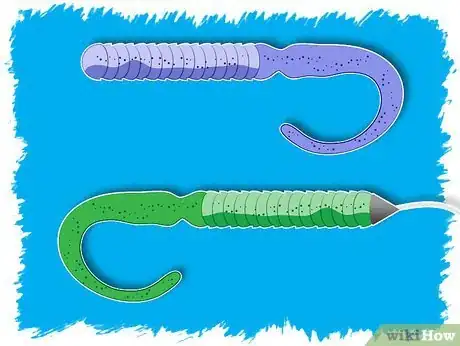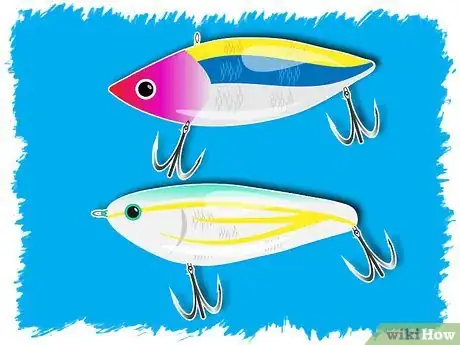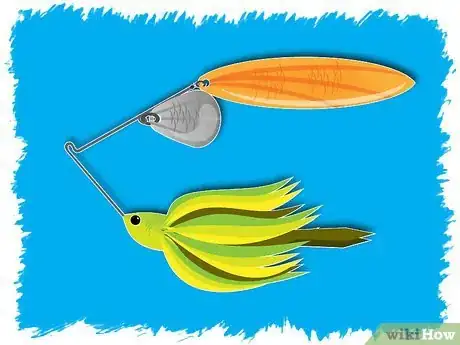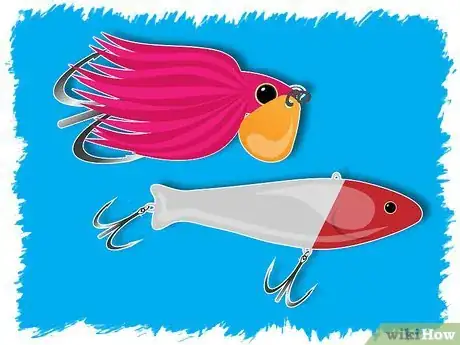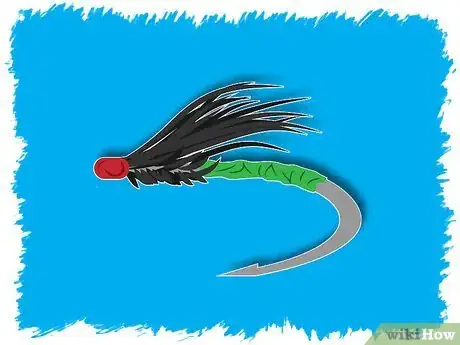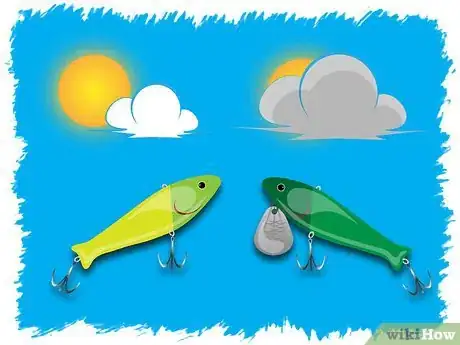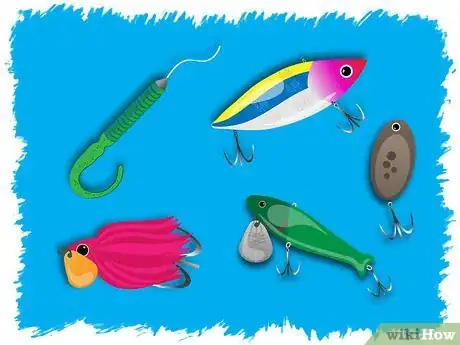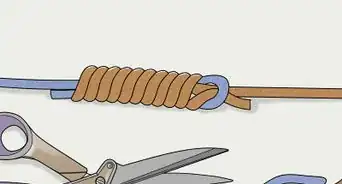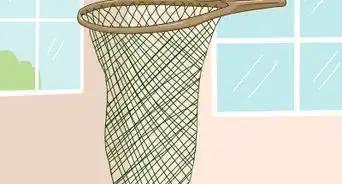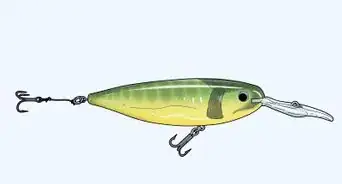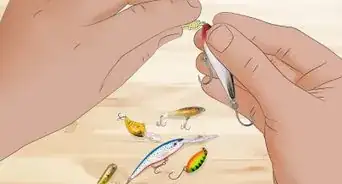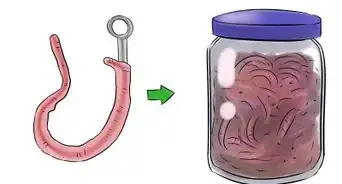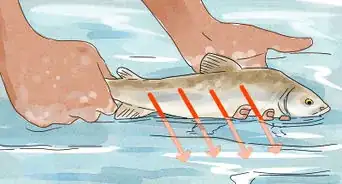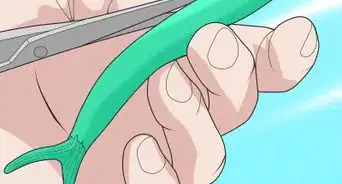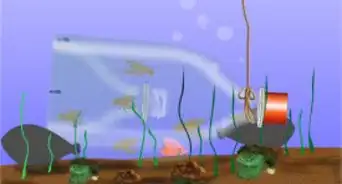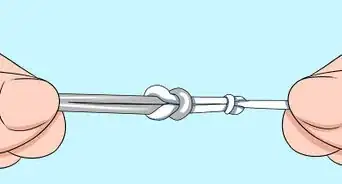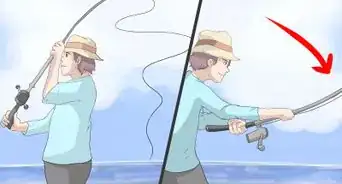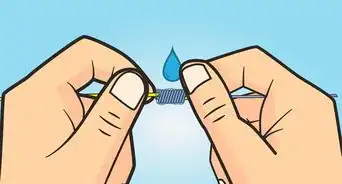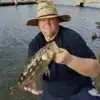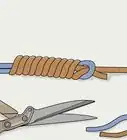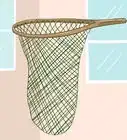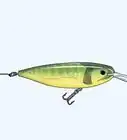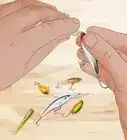This article was co-authored by Michael Reynolds. Michael Reynolds is a Professional Fishing Instructor and the Owner of Long Beach, California Fishing Lessons by Michael Reynolds. In his over 40 years of fishing experience, Michael has become very knowledgeable about the variety of fishing methods and techniques. He is passionate about sharing his knowledge with beginners to experienced anglers. Michael has been guiding and teaching fishing for over five years and is licensed and bonded with the Department of Fish and Wildlife (DFW).
wikiHow marks an article as reader-approved once it receives enough positive feedback. This article received 16 testimonials and 100% of readers who voted found it helpful, earning it our reader-approved status.
This article has been viewed 340,787 times.
Freshwater fishing lures come in a number of types, sizes, shapes, and colors. Although most freshwater lures are produced for the bass fishing market, artificial lures can be used to catch other species of fish, such as crappie, perch, walleye, northern pike, and muskellunge. While some lures go through cycles of being "hot" or "new" and then are quickly forgotten, many others have enjoyed years or even decades of popularity among all anglers. Although you can fill a large tackle box with many different types of lures, understanding which lures to use in which situations will make you a more effective fisherman. Following are steps on how to pick freshwater fishing lures based on the conditions you are fishing in and the species of fish you're trying to catch.
Steps
Matching Lure Types to Fish
-
1Use plastic worms when fishing for largemouth bass. Invented in 1949 by Nick and Cosma Crème and first marketed in 1951, plastic worms are probably the best-known largemouth bass lures. Available in a host of colors and lengths from 4 to 10 inches (10 to 25 cm), plastic worms have spawned a number of other soft plastic artificial lures: grubs, crayfish, and salamanders among them. Occasionally fished on the surface, plastic worms are most commonly fished in timber, brush, weeds, and along rocky drop-offs, and they are usually rigged by threading the hook through the worm so that its body covers the hook point and makes a self-weedless rig. (This rig is called a Texas rig when fished with a bullet-shaped slip sinker and a Carolina rig when fished with a leader, swivel, and egg-shaped slip sinker.)
-
2Use crankbaits in a variety of situations. Also known as plugs, crankbaits are artificial lures made of hard plastic. They are so named because they are designed to be cast out and retrieved, with some versions intended to be retrieved rapidly to trigger fish to strike them aggressively. Although some are weedless, they are usually not intended to be fished around weeds, brush, or timber. Crankbaits come in several varieties, as described below:
- Topwater lures are designed to be fished on the surface. These include poppers, which feature a vertical concave surface that makes a popping noise when jerked with the rod tip; wobblers, which feature plates that cause the lure to move from side to side when retrieved; and stick baits, which are thin lures without any special attachments that are given their action solely by the fisherman.
- Thin minnow lures are shaped and usually colored like minnows. They feature a small lip at the front, differentiating them from stick baits; otherwise, they may be fished on the surface or underwater, usually with a twitching motion. Normark's Rapala is the best known lure of this type.
- Swimming crankbaits, or swim baits, are artificial lures designed to move from side to side as they are pulled through the water. One style of this type of lure is curved with a flat or concave surface at the head, which functions similarly to the lip on a thin minnow in causing the lure to swim. The Lazy Ike and Helin Flatfish are 2 examples of this type of lure.
- Diving lures feature a larger lip than thin minnows, enabling them to dive deeper when retrieved or trolled; the larger the lip, the deeper it dives. These lures may have either long, thin bodies, or short, stocky bodies. The faster the lure is retrieved, the deeper it will dive; if the retrieve is stopped, the lure, being hollow, will usually rise to the surface, although some crankbaits will remain suspended at the depth they reached.
Advertisement -
3Use spinnerbaits in situations where other lures would get hung up. Sometimes called safety-pin spinners for their resemblance to an open safety pin, spinnerbaits feature a weighted end with a single hook and skirt and an end with 1 or more spinners. Spinnerbaits can be fished by being rapidly retrieved across the surface so that the blades flash and splash, bumped off standing timber, or let fall to the bottom around drop-offs and other vertical structures.
- Spinnerbaits come equipped with either propeller- or teardrop-shaped blades. Teardrop-shaped blades are further divided into 3 types: the willow-leaf, which is narrow and pointed on both ends; the Indiana, which is a rounded-end version of the willow-leaf; and the Colorado, which is broad and rounded at 1 end and comes to a rounded point at the other.
- Related to the spinner bait is the inline, or French, spinner, which features a tubular metal body with a willow-leaf or Indiana blade spinner ahead of it and a treble hook with a feather skirt behind it. French spinners are usually fished around rocky areas or in streams and attract trout, smallmouth bass, and walleye more than largemouth bass
-
4Use jigs any time during the year. Jigs consist of a hook with a weighted head and either feature a hair or feather skirt or a plastic grub. Most jigs have round heads, but some jigs feature flat or triangular heads that either impart a swimming motion or keep the hook upright and out of rocks and weeds. Jigs are normally retrieved in an up-and-down motion and can be fished in warm or cold water situations, usually by slowing the retrieve as the water gets colder. Some jigs feature stiff brush or wire guards to keep them weedless, while most feature only a bare hook. Nonetheless, the best places to fish jigs are usually those places where they can get hung up, near weeds, brush, or rocks. (Jigs are the cheapest type of artificial lure, however, so the loss of a few jigs is usually not as consequential as the loss of a crank bait.)
- Some jigs are rigged with removable safety-pin spinners, usually with a small grub body. The most familiar jig of this type is the Bass Buster Beetle Spin, a popular lure for a number of fish species.
- Jigs may be fished in several ways. When fishing for bass, jigs are often flipped or pitched short distances instead of being cast long distances like most lures. They are usually retrieved with a lift-and-drop motion, slowly raising and lowering the rod so that the jig falls on a taut line. They may also be retrieved straight, with the rod kept at a 10 o'clock position to impart a swimming motion to the lure.
-
5Use spoons for a number of different species. One of the oldest lures, the spoon was developed in 1850 by Julio T. Buel of New York, supposedly by cutting the handle off a teaspoon and putting a hook on it. The resemblance to the bowl of a spoon causes spoons to wobble from side to side as they are retrieved, which is what draws fish to them. Smaller spoons have been used to fish for trout and panfish, while larger spoons have been used to fish for bass, pike, walleye, and other large fish.
- Most spoons are designed to fish below the surface; these spoons feature a treble hook attached with a split ring. Two of the best-known spoons of this type are the Eppinger Dardevle, most familiar in its red-and-white striped pattern, and the Hofschneider Red-Eye, noted for 2 plastic eye-beads and hooks at the front and back. Thicker versions of these spoons may be cast or trolled, with the thickest designed to be fished like jigs, while the thinnest versions are designed exclusively for trolling.
- Another type of spoon features a single wire-weedless hook whose shank is attached to the back of the spoon. This type of spoon is designed to be rapidly retrieved across the surface and is often dressed with a strip of pork rind or other bait attached to the hook.
-
6Use flies when fishing for trout. Flies consist of a single hook with either a hair or feather skirt. They are the smallest and lightest fishing lure and are usually used when stream fishing for trout, using special rods that cast weighted line with the fly attached with a monofilament leader. Flies are available in a number of patterns to match fly species trout feed on; many anglers tie their own flies, sometimes even at stream side to "match the hatch." Flies are available in 5 types, described below:
- Dry flies float on the surface and are usually dressed with a waterproofing compound to keep them from waterlogging and sinking. They are attached to a floating line and fished in a way that matches the natural surface motion of the insect they are imitating.
- Wet flies are designed to sink and to simulate swimming or drowning insects, as well as insects either laying eggs or hatching from them. They can be fished with floating, sinking, or sinking-tip lines, according to how deep you want to fish the fly. In calm water, you cast a wet fly beyond the fish's position and let it sink to the proper depth before retrieving it in as natural a fashion as you can. In moving water, you cast closer to and upstream from the fish and let the water move the fly to the fish.
- Nymphs are a form of wet fly that simulates young insects or other small aquatic life. They are generally fished the same way as other wet flies.
- Streamers may be fished the same way as either a dry or a wet fly. They are intended to simulate minnows or other small fish.
- Bugs are dry flies designed to suggest large insects, amphibians, mice, or injured minnows. Some are designed with popper heads, like the topwater plug previously mentioned. They can be fished with either a floating or sinking-tip line.
- Some fly fishermen fish multiple flies to determine which type of fly the fish are biting. It is possible to combine several fly types when doing this; however, you'll need to consult the fishing regulations for your state to determine how many hooks (lures) you can have attached to your line at once.
Choosing the Right Lure
-
1Choose lure colors according to weather and water conditions. The general rule for lure color is "bright day, light colors; dark day, dark colors." On bright, sunny days and in clear water conditions, choose lures that are light in color and mimic natural patterns. On cloudy days and in dirty water conditions, choose darker lures and those with a non-natural coloration, preferably types that make noise or vibrate as they move through the water.
- A notable exception to this rule is the use of 2-toned plastic worms that feature a darker head color and a fluorescent pink or yellow tail color. Many anglers use plastic worms colored like this when fishing in cloudy water conditions.
- Choose lure colors based on the bait living in the area.
-
2Choose lure size according to the tackle you're using and the species you're fishing for. In general, choose smaller jigs and grubs when fishing for panfish (bluegill, sunfish, crappie, perch) and larger lures such as spinnerbaits and crankbaits when fishing for bigger fish (bass, walleye, and pike). Smaller lures are best suited for light and ultralight spinning and spincasting tackle (or fly rods in the case of dry and wet flies) with lines of 4 to 10-pound test (2 to 5 kg class), while larger lures are meant to be fished with medium to heavy action rods, spinning or baitcasting reels, and lines of 12 to 20-pound test (6 to 10 kg class) or better. (Lures used to fish for muskellunge, the largest member of the pike family, are decidedly larger than those used for bass, walleye, and northern pike, and often require the use of a wire leader because of the muskie's sharp teeth.)
- Lure size can also be dictated by weather conditions and how fish react to them. In early spring, or when cold front conditions clear the skies and cool the water to make fish lethargic, smaller lures are usually better choices than larger lures. (Lures used for ice fishing are exceptionally tiny, usually grub jigs or small spoons.) In high-wind conditions, you may need to use a larger lure simply to have enough resistance on the end of the line to keep the wind from bowing it so that you can't detect if fish are hitting the lure. Also try casting out a spinner and just keep casting and retrieving the lure.
Community Q&A
-
QuestionWhat is a small wire that attaches to a lure called?
 Community AnswerA leader. Leaders are also useful when fishing for fish with sharp teeth like pike, pickerel and muskies, so they don't bite through your fishing line.
Community AnswerA leader. Leaders are also useful when fishing for fish with sharp teeth like pike, pickerel and muskies, so they don't bite through your fishing line. -
QuestionDoes time of day and water temperature influence the effectiveness of using a lure?
 Community AnswerYes, when water warms up in the heat of the day, fish tend to dive deeper and find cover to stay as cool as possible.
Community AnswerYes, when water warms up in the heat of the day, fish tend to dive deeper and find cover to stay as cool as possible. -
QuestionIs there a lure I can use without a hook?
 Community AnswerNo. There would be no way to catch the fish. But something I have figured out is if you have a bobber then a lure without a hook (just take the hook off) there is a chance it will see your bobber and bite it.
Community AnswerNo. There would be no way to catch the fish. But something I have figured out is if you have a bobber then a lure without a hook (just take the hook off) there is a chance it will see your bobber and bite it.
Warnings
- There is no one artificial lure or presentation that will work in all conditions for a particular species, nor is there a lure that will be equally attractive to all fish species at all times. Try several fishing methods and then concentrate on those methods that you are most comfortable with and choose those lures that you have the most confidence in.⧼thumbs_response⧽
- If you fish with both plastic worms and crankbaits, keep the plastic worms separate from the plugs, as the soft plastic will react with the hard plastic used to make crankbaits. You can either keep them in separate trays or use a special plastic case or resealable bags to keep the worms in.⧼thumbs_response⧽
References
- http://www.bassfishingandcatching.com/largemouth-bass-lure.html
- http://www.bassresource.com/fish/jigs.html
- Rodney Ruff, Omaha, NE; one-time avid fisherman and reader of fishing magazines
About This Article
If you’re trying to pick freshwater fishing lures, choose plastic worms to catch largemouth bass, especially when you’re fishing in weeds or brush. To fish in a wider variety of situations, consider using crankbaits or spoons, both of which are meant to be drawn in so the motion attracts fish. Regardless of the lure type, use lighter lures during bright days, and dark lures at night. To learn how to fish when it’s windy or cold, scroll down!
